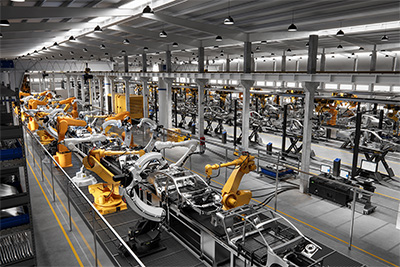From the factory floor to the supply chain, from artificial intelligence to the Internet of Things (IoT), technology is revolutionizing the way goods are produced, distributed, and consumed.
In the rapidly evolving landscape of industrial production, the current era of industry digitalization (often referred to as the fourth industrial revolution) is reshaping traditional manufacturing paradigms by seamlessly integrating cutting-edge technologies into every facet of production.
In this article, we explore a few shopfloor plants’ maintenance strategies — from preventive maintenance that can fix issues before they occur following a planned maintenance schedule, and progressively move to a predictive maintenance, a proactive approach to predict machine failures.
Components of a robust shop floor strategy
Let us first examine the essential components required for a leading and strategic shop floor strategy.
- IIoT connectivity: It is critical for the shop floor to support machine connectivity and data collection from programmable logic controllers (PLCs) and sensors on the shop floor, streaming data to the Cloud via IIoT edge gateway devices.
- IIoT platform with data hub intelligence: Secure data connectivity, data modelling, conditioning, and unified namespace management for SCADA, MES, CMMS, and ERP data sources are key elements for quicker, streamlined data collection.
- Data Analytics and AI: Cloud-native IIoT Platform components should be deployed on a scalable and secure cloud infrastructure, enabling shop floor-wide IIoT use cases and data analytics. Machine learning models trained and tested on the IIoT Cloud platform can also be deployed at the Edge for local site-specific, near real-time predictions and recommendations.
- System integration and API connectors: This supports seamless integration with data-driven application use cases.
Four factors for a winning predictive maintenance strategy
Drawing from my experience in the Manufacturing industry, I have identified some key considerations for factories that are keen to adopt predictive maintenance strategies:
- Legacy systems integration: Many factories operate with legacy equipment and systems that may not be compatible with modern predictive maintenance solutions, and this can be a real challenge the longer you delay it.
- Data quality and consistency: The success of predictive maintenance models relies on high-quality, standardized data collected from various sources across all shop floor sites.
- Interoperability: Factories often have equipment from different vendors, leading to fragmented solutions across multiple factories. Careful planning is needed to address differences between factories, considering many manufacturers have grown through acquisitions.
- Scalability: Predictive maintenance solutions must be scalable to handle the volume of data accumulated over time and accommodate the growth of the customer’s estate.
Strategize. Streamline. Secure.
How can you leverage predictive maintenance for your shop floor? These fundamental strategies help overcome the above-mentioned challenges and ensure a successful deployment of predictive maintenance solutions.
Let’s take a look:
- Clearly defined objectives – Start by clearly defining the objectives and goals of your predictive maintenance initiative. Determine the key performance indicators (KPIs) desired to improve e.g. equipment uptime, maintenance costs, or overall equipment effectiveness (OEE).
- Data acquisition and integration – Ensure robust data acquisition from sensors, IoT devices, and other sources to gather relevant data on equipment health and performance. Integrate data from disparate sources such as equipment sensors, maintenance logs, and operational systems into a centralized data repository for analysis. Consider a unified namespace (UNS) that implements an effective data architecture for shopfloor data integration adhering to industry standards.
- Data quality and preprocessing – Enhance your data quality by addressing issues such as missing values, outliers, and inconsistencies in the data. Preprocess the data to clean, normalize, and transform it into a suitable format for analysis.
- Feature engineering – Identify relevant features or variables from the data that are predictive of equipment failures or degradation. Conduct feature engineering to extract meaningful insights from the data, including time-series analysis, signal processing, and domain knowledge integration.
- Model development and selection – Select appropriate machine learning algorithms and techniques for predictive maintenance, such as regression, classification, or anomaly detection. Train and validate predictive models using historical data to accurately predict equipment failures or maintenance needs.
- Real-time monitoring and alerts – Implement real-time monitoring capabilities to continuously monitor equipment health and performance. Set up automated alerts and notifications to trigger maintenance actions or interventions when early signs of equipment degradation or failure are detected.
- Integration with maintenance workflows – Integrate predictive maintenance insights into existing maintenance workflows and systems. Ensure seamless communication and collaboration between maintenance teams, operations teams, and data analysts to prioritize and schedule maintenance activities effectively.
- Continuous improvement and iteration – Implement a feedback loop to continuously monitor and evaluate the performance of predictive maintenance models. Collect feedback from maintenance actions and equipment performance to refine and improve predictive models over time.
- Scalable, future-proof approach – Begin with a pilot project to validate the concept’s efficacy and then scale it across multiple production lines or factories.
- Change management and organizational readiness – Ensure that the organization is prepared for the cultural and operational changes associated with predictive maintenance implementation.
Confidence, clarity and consulting
Eviden’s vast experience with global industry-leading manufacturers has broadened our understanding of the intricacies in the sector. We understand that each manufacturing shop floor landscape is unique, with its own set of opportunities and obstacles. That is why we offer tailored solutions and expert guidance to help you navigate the complexities of digital transformation with confidence and clarity.
Our connected factory IoT experts have already rolled out key projects across manufacturing shop floors for our clients. In fact, we have created tailored ISA-95 compliant IIoT reference architectures that can be deployed in most of the factories across the manufacturing industry. Whether you’re a small-scale operator or a global enterprise, you will soon venture out on your transformation journey and launch your very-own predictive maintenance. We are here to support you at every step of your journey towards manufacturing excellence.
- Connect with me to discuss how you can make your shop floor strategy a reality and tangible success.
- Learn more about Eviden’s IoT Connected Factory solution and Digital process twin to see how it can be tailored to your organizational needs.





